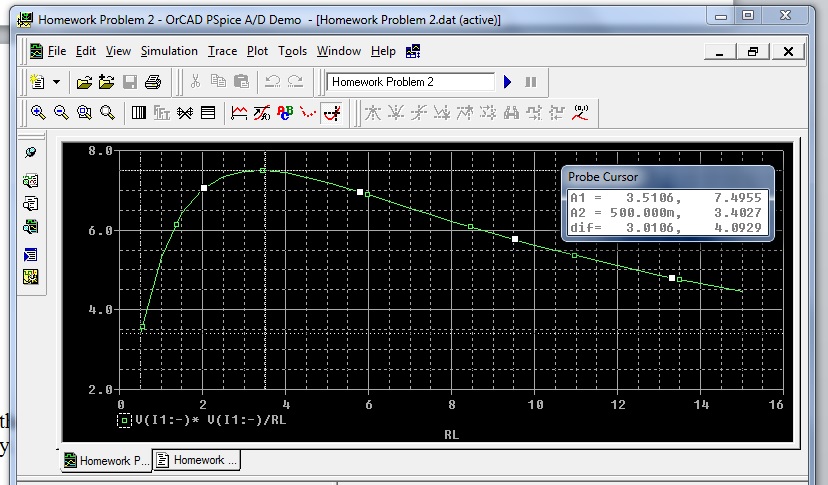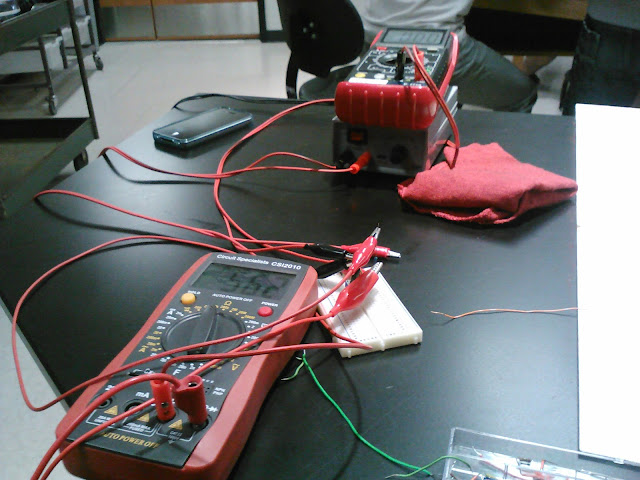We started by building this circuit layout:
We are given the task to come up with a circuit that ranges between 0 and -10V which has to consume 1mA or less of current from a sensor that ranges from 0 to +1V. In other words, we have to build an inverting amplifier with a gain of -10.
Step 1A:
We need to first calculate Ri ( input resistance ), given that the voltage in the sensor ranges from 0 - 1V
V = iR, R = V/i = 1/0.001 = 1000 ohms
Step 1B:
Next we need to assign an Rf (feedback resistor),
R = V/i = 10/0.001 = 10,000 ohms
When we introduce our 'sensor', the circuit schematics will be slightly changed;
Step 1C:
Disconnecting the inverting amplifier, we can obtain Rx by assuming we want to operate it at half of its standard 1/4W power rating;
1/8 = 12^2/Rx, Rx = 1152ohms
Although we could not get an exact 1152 ohm resistor, we obtained a 1300 ohm resistor
Step 1D:
To find Ry, we use voltage divider in series for both Rx and Ry, provided that there's no loading in Ry and that there's 1V across Ry;
1 = 12Ry/ (1152 + Ry), and Ry = 104.72, using 130 ohm resistor
Step 1E:
Next, we need to find Rth for the circuit
1/1152 + 1/104.72 = 1/Rth
Rth = 96 ohms
Step 1F:
We found out that the Thevenin Resistance is NOT above at least a factor of 20 times smaller than Ri. This means that we'll need to choose a considerably larger value for Ri. Ri = 3,000 ohms and Rf = 30,000 ohms.
Step 2: Measuring components
| Component | Nominal | Measured | Rating |
| Ri | 3000 ohms | 2999+/-2 ohms | 1/8 |
| Rf | 30000ohms | 29998+/-2 ohms | 1/8 |
| Rx | 1300 ohms | 1299 +/-1 ohms | 1/8 |
| Ry | 130 ohms | 129+/-1 ohms | 1/8 |
| V1 | 12V | 12.27+/- .1 V | 2 amps |
| V2 | 12V | 12.27+/-.1 V | 2amps |
Step 3: Circuit overview
Step 4: Performing experiment
| Vin (V) | Vout (V) | Gain | Vri (V) | Iri (mA) | Vrf (V) |
| 0.00 | 0 | 0 | 0 | 0 | 0 |
| 0.25 | 2.79+/-.01 | 0.0896+/-.00032 | 0.251+/-.001 | 0.0837+/-.00034 | 2.79+/-.02 |
| 0.50 | 5.55+/-.02 | 0.0901+/-.00032 | 0.494+/-.001 | 0.1647+/-.00035 | 5.49+/-.01 |
| 0.75 | 8.29+/-.02 | 0.0905+/-.00022 | 0.745+/-.002 | 0.2483+/-.00069 | 8.29+/-.01 |
| 1.00 | 10.71+/-.01 | 0.09337+/-.000087 | .968+/-.001 | 0.3228+/-.00040 | 10.77+/-.02 |
We measured the current in V1 to be 0.96+/-.01mA and the current in V2 to be -1.29+/-.02mA.



















